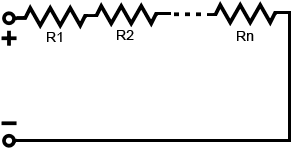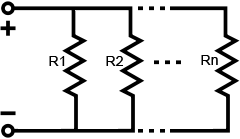Resistor Calculator
- First bands: Digit values (Black=0, Brown=1, etc.)
- Multiplier band: Multiply by value (Black=1, Brown=10, etc.)
- Tolerance band: ±% (Gold=5%, Silver=10%, etc.)
- PPM band: Temperature coefficient
Brown (1), Black (0), Red (100), Gold (5%)
= 10 × 100 = 1000Ω ±5%
Resistors in Series
Rtotal = R1 + R2 + R3 + ...
Example:
100Ω + 220Ω + 330Ω = 650Ω
Parallel Resistors
1/Rtotal = 1/R1 + 1/R2 + 1/R3 + ...
Example:
1/(1/100 + 1/220 + 1/330) ≈ 56.60Ω
Conductor Resistance
R = ρ × (L/A)
Where:
ρ = resistivity, L = length, A = area
Example:
Copper wire (ρ=1.68×10-8Ω·m)
10m length, 2.5mm² area:
R = 1.68e-8 × (10/2.5e-6) ≈ 0.0672Ω
Understanding the Resistor Color Code
Resistor color codes are a standardized way to indicate the resistance value of resistors using colored bands. While this method is also applied to components like capacitors and inductors, it is most commonly used for resistors, which are the focus of this tool.
This color-coding system is defined by the international standard IEC 60062. It allows users to identify resistor values, tolerances, and other specifications at a glance based on the position and color of the bands.
How the Color Bands Work
A typical resistor features 4, 5, or 6 color bands, each representing specific values or properties. Here’s how to read them:
4-Band Resistor Example
For a resistor with color bands: Green, Red, Blue, and Gold:
1st Band (Green) = 5
2nd Band (Red) = 2
3rd Band (Blue) = Multiplier ×1,000,000
4th Band (Gold) = Tolerance ±5%
This translates to a value of:
52 × 1,000,000 = 52,000,000 Ω (or 52 MΩ)
With a ±5% tolerance, the resistor could range from 49.4 MΩ to 54.6 MΩ.
Color Code Chart for Resistors
| Color | Digits (1st–3rd) | Multiplier | Tolerance | Temp. Coefficient (ppm/K) |
|---|---|---|---|---|
| Black | 0 | ×1 | — | 250 (U) |
| Brown | 1 | ×10 | ±1% (F) | 100 (S) |
| Red | 2 | ×100 | ±2% (G) | 50 (R) |
| Orange | 3 | ×1K | ±0.05% (W) | 15 (P) |
| Yellow | 4 | ×10K | ±0.02% (P) | 25 (Q) |
| Green | 5 | ×100K | ±0.5% (D) | 20 (Z) |
| Blue | 6 | ×1M | ±0.25% (C) | 10 (Z) |
| Violet | 7 | ×10M | ±0.1% (B) | 5 (M) |
| Grey | 8 | ×100M | ±0.01% (L) | 1 (K) |
| White | 9 | ×1G | — | — |
| Gold | — | ×0.1 | ±5% (J) | — |
| Silver | — | ×0.01 | ±10% (K) | — |
| None | — | — | ±20% (M) | — |
5-Band and 6-Band Resistors
Resistors limit electrical current and are key elements in all types of electronic circuits. Their total resistance depends on how they are connected.
Resistors in Series
Resistors in a series simply add up:
Total Resistance (R) = R1 + R2 + R3 + … + Rn

Resistors in Parallel
In parallel, total resistance is calculated as:
1 / Total Resistance (R) = 1 / R1 + 1 / R2 + 1 / R3 + … + 1 / Rn
For just two resistors in parallel, you can also use:
Total Resistance (R) = (R1 × R2) / (R1 + R2)

Resistance Formula for Conductors
To calculate resistance based on material and size:
R = L / (A × C)
Where:
R = Resistance (Ω)
L = Length of the conductor
A = Cross-sectional area
C = Conductivity of the material
